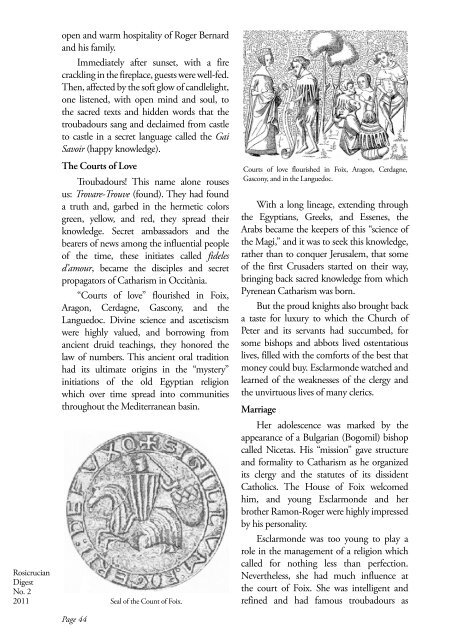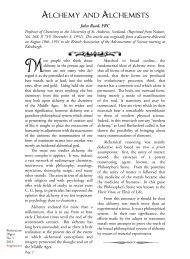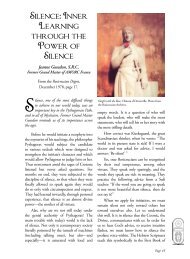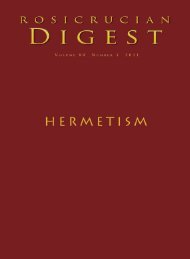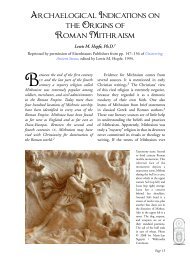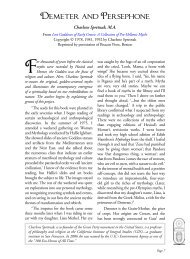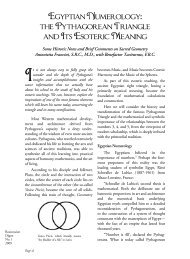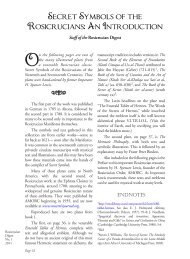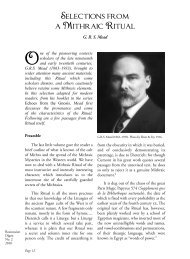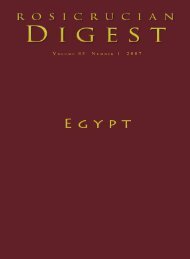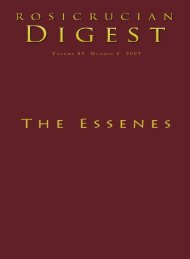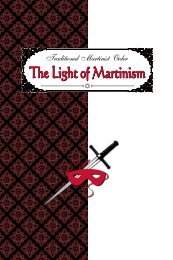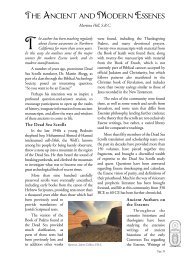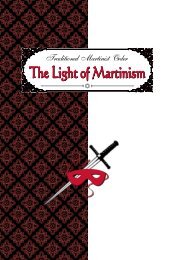Rosicrucian Digest Vol 89 No 2 2011 Gnosticism - Rosicrucian Order
Rosicrucian Digest Vol 89 No 2 2011 Gnosticism - Rosicrucian Order
Rosicrucian Digest Vol 89 No 2 2011 Gnosticism - Rosicrucian Order
You also want an ePaper? Increase the reach of your titles
YUMPU automatically turns print PDFs into web optimized ePapers that Google loves.
<strong>Rosicrucian</strong><br />
<strong>Digest</strong><br />
<strong>No</strong>. 2<br />
<strong>2011</strong><br />
open and warm hospitality of Roger Bernard<br />
and his family.<br />
Immediately after sunset, with a fire<br />
crackling in the fireplace, guests were well-fed.<br />
Then, affected by the soft glow of candlelight,<br />
one listened, with open mind and soul, to<br />
the sacred texts and hidden words that the<br />
troubadours sang and declaimed from castle<br />
to castle in a secret language called the Gai<br />
Savoir (happy knowledge).<br />
The Courts of Love<br />
Troubadours! This name alone rouses<br />
us: Trovare-Trouve (found). They had found<br />
a truth and, garbed in the hermetic colors<br />
green, yellow, and red, they spread their<br />
knowledge. Secret ambassadors and the<br />
bearers of news among the influential people<br />
of the time, these initiates called fideles<br />
d’amour, became the disciples and secret<br />
propagators of Catharism in Occitània.<br />
“Courts of love” flourished in Foix,<br />
Aragon, Cerdagne, Gascony, and the<br />
Languedoc. Divine science and ascetiscism<br />
were highly valued, and borrowing from<br />
ancient druid teachings, they honored the<br />
law of numbers. This ancient oral tradition<br />
had its ultimate origins in the “mystery”<br />
initiations of the old Egyptian religion<br />
which over time spread into communities<br />
throughout the Mediterranean basin.<br />
Page 44<br />
Seal of the Count of Foix.<br />
Courts of love flourished in Foix, Aragon, Cerdagne,<br />
Gascony, and in the Languedoc.<br />
With a long lineage, extending through<br />
the Egyptians, Greeks, and Essenes, the<br />
Arabs became the keepers of this “science of<br />
the Magi,” and it was to seek this knowledge,<br />
rather than to conquer Jerusalem, that some<br />
of the first Crusaders started on their way,<br />
bringing back sacred knowledge from which<br />
Pyrenean Catharism was born.<br />
But the proud knights also brought back<br />
a taste for luxury to which the Church of<br />
Peter and its servants had succumbed, for<br />
some bishops and abbots lived ostentatious<br />
lives, filled with the comforts of the best that<br />
money could buy. Esclarmonde watched and<br />
learned of the weaknesses of the clergy and<br />
the unvirtuous lives of many clerics.<br />
Marriage<br />
Her adolescence was marked by the<br />
appearance of a Bulgarian (Bogomil) bishop<br />
called Nicetas. His “mission” gave structure<br />
and formality to Catharism as he organized<br />
its clergy and the statutes of its dissident<br />
Catholics. The House of Foix welcomed<br />
him, and young Esclarmonde and her<br />
brother Ramon-Roger were highly impressed<br />
by his personality.<br />
Esclarmonde was too young to play a<br />
role in the management of a religion which<br />
called for nothing less than perfection.<br />
Nevertheless, she had much influence at<br />
the court of Foix. She was intelligent and<br />
refined and had famous troubadours as


